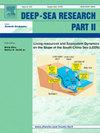南印度洋西部温跃层的再矿化信号:从营养化学计量学诊断当地生物地球化学过程
IF 3
3区 地球科学
Q2 OCEANOGRAPHY
Deep-sea Research Part Ii-topical Studies in Oceanography
Pub Date : 2025-10-01
DOI:10.1016/j.dsr2.2025.105549
引用次数: 0
摘要
南印度洋西部是热带和亚热带水域交汇的高度动态区域。与其他海洋地区一样,它的温跃层的营养条件在设定区域生产力方面起着关键作用,但它们在很大程度上仍未得到研究。本文通过对莫桑比克海峡南北入口、马达加斯加东南海流和阿古拉斯海流收集的WOCE数据进行区域最优多参数分析,研究了改变南印度洋西部温跃层营养成分比例的局部生物地球化学过程。我们首先量化了三个近源水(赤道、热带、亚热带)对区域温跃层(~ 100-900米)的相对贡献,以及这些源水的等环流混合预期的营养物质(即硝酸盐和磷酸盐)清单。然后,我们利用预期和观测到的养分浓度和比例之间的差异来诊断当地生物地球化学过程的发生,如有机物再矿化和N2固定。我们发现,莫桑比克海峡的两个入口具有明显的特征,营养丰富的热带水源主导了北部入口(>55%),而营养贫乏的亚热带水源主导了南部(>80%)。在北部入口,相对于近源水提供的营养物,重叠的营养物添加和去除过程只会导致温跃层营养物存量的微小变化,没有局部氮固定的证据。相比之下,莫桑比克海峡以南(>25°S),包括马达加斯加东南海流和阿古拉斯海流,一个强烈的局部再矿化信号表明副热带温跃层的营养物质增加。这些营养物相对于近处和下面的水源水提供的营养物具有较高的硝酸盐与磷酸盐比率,我们将其解释为局部氮固定的证据。我们的分析表明,在亚热带西南印度洋,N2固定发生在局部,它将促进区域生产力和碳出口。本文章由计算机程序翻译,如有差异,请以英文原文为准。
Remineralisation signals in the western South Indian Ocean thermocline: diagnosing local biogeochemical processes from nutrient stoichiometry
The western South Indian Ocean is a highly dynamic region where tropical and subtropical waters converge. As in other ocean areas, the nutrient conditions of its thermocline play a critical role in setting regional productivity, yet they remain largely unstudied. Here, we investigate local biogeochemical processes that alter thermocline nutrient ratios in the western South Indian Ocean by applying a regional optimum multiparameter analysis to WOCE data collected across the northern and southern entrances to the Mozambique Channel, the Southeast Madagascar Current, and the Agulhas Current. We first quantify the relative contributions of three proximate source waters (Equatorial, Tropical, Subtropical) to the regional thermocline (∼100–900 m), along with the nutrient (i.e., nitrate and phosphate) inventories expected from isopycnal mixing of these source waters. We then use the difference between the expected and observed nutrient concentrations and ratios to diagnose the occurrence of local biogeochemical processes such as organic matter remineralization and N2 fixation. We find that distinct regimes characterize the two entrances to the Mozambique Channel, with nutrient-rich Tropical source waters dominating the northern entrance (>55%) while nutrient-poor Subtropical source waters dominate the south (>80%). At the northern entrance, overlapping nutrient addition and removal processes drive only minor changes to the thermocline nutrient inventory relative to the nutrients supplied by the proximate source waters, with no evidence of local N2 fixation. By contrast, south of the Mozambique Channel (>25°S), including across the Southeast Madagascar Current and Agulhas Current, a strong local remineralization signal indicates nutrient addition to the Subtropical thermocline. These nutrients have a high nitrate-to-phosphate ratio relative to those supplied by the proximate and underlying source waters, which we interpret as evidence of local N2 fixation. Our analysis shows that N2 fixation occurs locally in the subtropical southwest Indian Ocean where it will fuel regional productivity and carbon export.
求助全文
通过发布文献求助,成功后即可免费获取论文全文。
去求助
来源期刊
CiteScore
6.40
自引率
16.70%
发文量
115
审稿时长
3 months
期刊介绍:
Deep-Sea Research Part II: Topical Studies in Oceanography publishes topical issues from the many international and interdisciplinary projects which are undertaken in oceanography. Besides these special issues from projects, the journal publishes collections of papers presented at conferences. The special issues regularly have electronic annexes of non-text material (numerical data, images, images, video, etc.) which are published with the special issues in ScienceDirect. Deep-Sea Research Part II was split off as a separate journal devoted to topical issues in 1993. Its companion journal Deep-Sea Research Part I: Oceanographic Research Papers, publishes the regular research papers in this area.

 求助内容:
求助内容: 应助结果提醒方式:
应助结果提醒方式:


